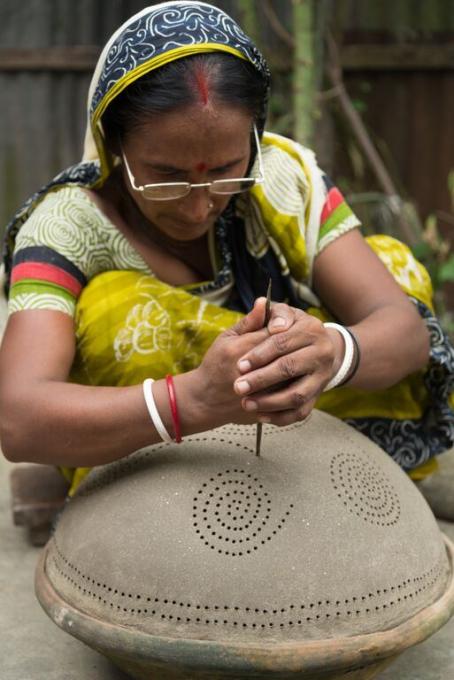Being customer-centric means testing, and re-testing, the assumptions in your value proposition
VisionSpring is a social enterprise with a blended revenue model that accelerates the uptake of eyeglasses among people living at the base of the pyramid (BoP), more specifically adults and children living on less than $4 a day. The organization employs 180 people in seven countries and reaches one million eyeglasses wearers annually. Depending on the region, VisionSpring serves customers directly or in collaboration with partners. A recent study published in THE LANCET Global Health—undertaken by VisionSpring, Orbis International, Queen’s University Belfast and funded by the charity Clearly—found that labour productivity among Indian tea pickers increased up to 32 per cent after they had been provided simple reading glasses. VisionSpring’s work and the link between clear vision, livelihoods and productivity have been covered recently by the New York Times and The Economist.
Could you briefly introduce yourself and your background and explain why you are passionate about your field of work?
I joined VisionSpring three years ago as president and to drive toward our objective of correcting the vision of 10 million people. In 2018 we will hit the half way mark, serving customer 5.4 million, and we will reach a million people with eyeglasses this year alone.
VisionSpring is a purpose-driven business, and we use whatever modality may be required to navigate the grey space that is social enterprise. We are a 501(c)3 non-profit and also a private limited company (PLC). We have a blended revenue model; backed by donors, and we also sell the eyeglasses.
We are accelerating the creation of an eyeglasses market for low income customers who are not served by the traditional optical sector. More than 50 percent of our customers are getting their first ever pair of glasses. Worldwide, 2.5 billion people don´t have the eyeglasses they need to earn and learn and be safe on the road. It’s exciting because it is green-field and solvable.
The majority of the people who need eyeglasses just need a very simple pair of reading glasses like the kind we can buy in Europe or the US in any pharmacy or train station. But they are not available in low-income settings. We find ourselves with an extraordinary opportunity. This 700-year old technology is affordable, simple, effective, and scalable. Many development problems are quite intractable. This one is infinitely fixable and with like-mind partners, we can solve this problem in a generation.
What does customer value mean to you?
First, let me clarify that we have B2B and B2C business models. So in some instances, VisionSpring is directly responsible for the end-consumer experience and interaction. In other instances, we are working through partners, currently more than 200 NGOs, hospitals, governments, and businesses.
Irrespective of the business model, at the heart of our value proposition is this: the glasses have to be radically affordable, durable, and attractive.
Radically affordable means they are priced within one to two day´s wages. Over the last 15 years, we have shown that low-income individuals are willing to pay this amount for the immediate benefits of clear vision and the income earning potential that comes with it.
Durability, because we work in environments, not unlike some pharmaceuticals, where low-grade products are present. This means people are spending their limited money on something that will break in three months. We want to make sure that anything we provide will last at least a year. If taken care of, we expect the average lifetime of our glasses to be two years. At that point, many customers will need a new power.
Glasses are on our faces. People everywhere need to feel confident that what they are wearing is attractive and suits them. People need choice and we must offer that. They want to choose a style that is personally fitting, and this helps counter social stigmas that deter people from wearing glasses. We always say that dignity and choice are not only the purview of the wealthy; everybody deserves that.
Beyond the product, we want the experience of getting glasses to be wonderful. For the poor, vision screening and glasses are usually the domain of the health sector. But who likes to go to the hospital? The whole idea of getting a vision screening can be intimidating and scary, if not inconvenient. Being considered a health commodity is actually working against uptake. So we look for ways to demedicalize the experience.
We bring the eyeglasses to where people are earning, learning, praying, and playing. It should be convenient, fun and exciting. People get to read their Koran for the first time in years or can thread their needle for the first time without asking a grandchild for help. There is wonder in that. A simple kind of magic. Getting glasses should not be intimidating.
How can businesses develop value propositions from the point of view of the customer? Why do you think many organizations are lacking this, and how can it be overcome?
Any of us asking low-income people to part with their limited income need to be really attuned to what is of value to them. We need to provide value because our customers are giving something of value, be it their limited discretionary funds, their time away from work or family, their effort or the cost of transportation to get to us. A value proposition is an exchange, and it starts on the customer’s side.
Sometimes the disconnect starts in our vocabulary. The word ‘beneficiary’ is a bad word at VisionSpring. We don’t use it, because it implies that we are giving something to somebody. There is this expectation of thanks and gratitude, and it really does not work that way. They are payers, paying in money, time and/or opportunity cost. Our job is to make sure that we are providing both a product and a service that is worth that payment.
Sometimes, there is a disconnect between the metrics of the donors and the best possible customer value. What could be done about that?
This disconnect can start with the use of logic models. Don’t get me wrong; I love a good logic model. But they are oriented to documenting program outcomes. They don’t require us to document and know our customers personas, their aspirations, desires, duties and constraints; and to design a product and service around that.
Starting with a traditional business canvas can be helpful. They have their limitations, but at the center of the business canvas is the value proposition. What are the customer´s gain and pain points? With our product or service, what pains are we reducing or eliminating? What gains are we creating? As for how the relationship is managed: Is it transactional or long-term? Then there are some traditional business metrics that fall out of that and can be worked into donor reporting, like sales conversion rates, customer retention, net promoter scores for understanding customer satisfaction, etc.
Sometimes, when we have programs that have been around for a long time, we can take what we are doing for granted. It is never too late to revisit the customer, their needs and their expectations. It’s never too late to define or redefine a value proposition.
If you would put yourself in the shoes of entrepreneurs just starting their business with a social approach, what key suggestions would you give to them? How do the metrics that donors ask for relate to metrics that are relevant from a customer perspective?
Chances are somebody has already tried to solve the problem we have identified. So the first place to start is to look at all the approaches that have already been tried and ‘borrow’ from all the learnings of the past.
Then talk to people. Talk to a lot of people who are potential customers and spend time with them. In figuring out how to serve them – and also how to segment them – surface as many problems or objections as possible. As my colleague likes to say, if you don’t solve for objections early, those objections will just be doing bench presses in the corner, getting stronger to knock you down later.
Donors regularly ask about risk, but they don’t often ask about product-market fit. It’s on us to introduce that and to demonstrate early demand.
Also, when we first start out, we are making a lot of assumptions about our customers, business model and targets. I’d recommend sharing those assumptions with donors and letting them know where the assumptions could be wildly wrong and could dramatically impact the performance on metrics.
As a practical tool when developing new businesses, Strategyzer can be useful. They have a business model canvas and a value proposition canvas that provides a structured approach for thinking through the pieces.
Women are often the majority of the BoP, but not always reached effectively. Are there particular ways to reach them?
One of our core values, which is written into our strategic framework is: empower women and girls. To make sure we are executing against that objective, we always disaggregate our data, at the screening and purchase level, by gender.
A gender-lens is really important for us. It would be a gross misunderstanding to assume that women who are low-literacy and who are not earning formal wages would not benefit from glasses, and that their clear vision would not be important to the household. Women do many tasks that require clear vision, particularly at near distances, and which provide social and economic value in the home and for cottage industry; everything from sorting stones out of the rice, deboning fish, weaving, sewing and handicraft making, caring for children, even using a mobile phone. For those who are literate, being able to help their children with homework, being able to read their holy texts, those are added layers of benefit.
In terms of choosing roots to market that bias to women, we are purposeful about that. In India for example, we have a strategic partnerships with Self-Employed Women´s Association (SEWA) and Educate Girls. In Bangladesh, we have worked with BRAC for the last decade. BRAC has an almost unparalleled, community health worker network, who are almost exclusively women. They are selling a wide variety of health products from oral hydration solution to contraception. In their basket of goods are eyeglasses. Of our 1.2 million customers who have purchased glasses through this community health worker channel, sixty two percent are women.

